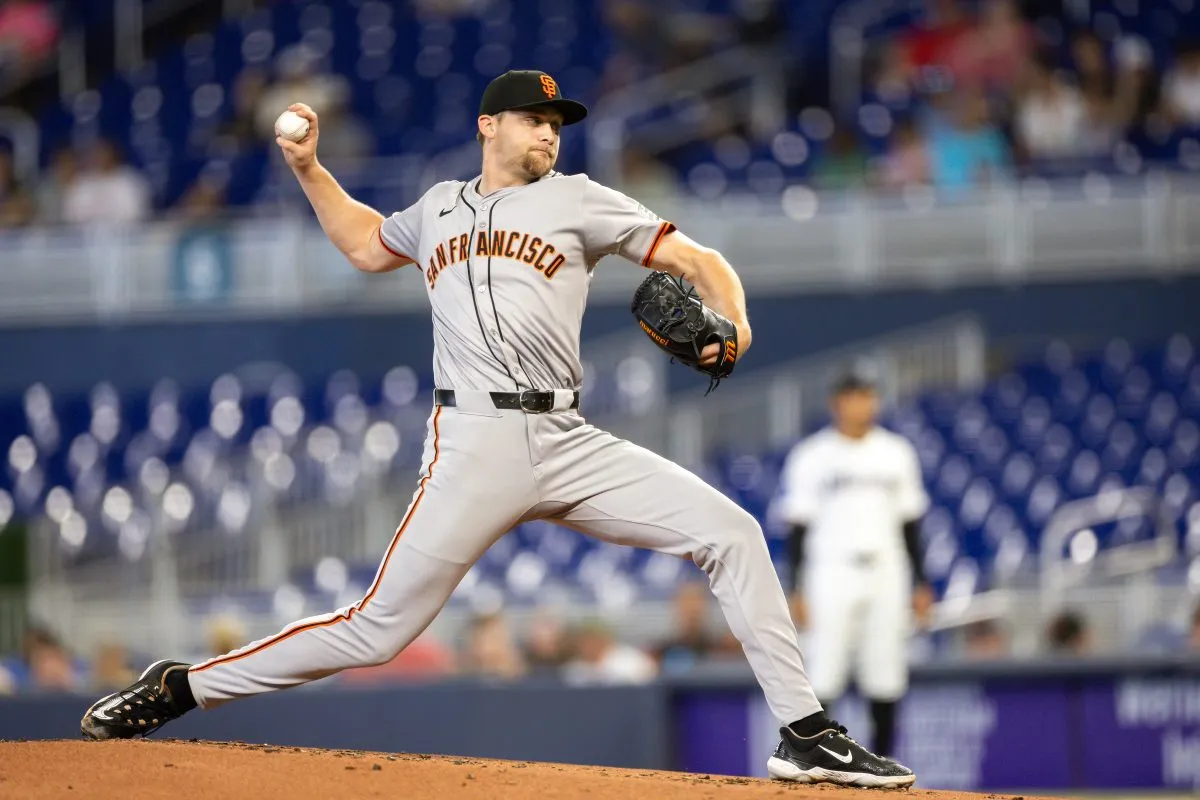SAN FRANCISCO -- As the top of the eighth inning approached on Sunday, Gabe Kapler started running through his mental checklist of traits he looks for in a position player who might be able to save some bullpen bullets in a 10-1 game.
The first key, of course, is that the player is fully healthy. Then he needs to be comfortable handling any hard grounders or line drives back to the mound, and he needs to be someone who won't be anxious about trying to throw strikes. But none of those are the most important thing.
"The first and most honest way to answer this question is you just start asking people, 'Hey, did you ever pitch before?'" Kapler said Monday afternoon, smiling. "I asked [Michael] Papierski yesterday. I was like, 'Hey, did you ever pitch?' and he was like, 'No.' I was like, 'Okay, I'll talk to you later about something else.'"
Stay in the game with the latest updates on your beloved Bay Area and California sports teams! Sign up here for our All Access Daily newsletter.
For the second time in eight days, Kapler settled on outfielder Luis Gonzalez, and a day later he talked glowingly of what Gonzalez has meant to the bullpen. As Kapler sat in the dugout on Monday afternoon, no part of him wanted to go through the checklist again that night, but when the Giants fell way behind the New York Mets, he once again turned to Gonzalez.
The outfielder became the first position player in franchise history to pitch on back-to-back days, and he likely isn't done. This is not a two-way player conversation, but the Giants are a group that spends every free moment asking how any microscopic edge can be gained. Gonzalez has proven to be remarkably effective in saving the bullpen, all while displaying a fully unique style.
There have been 86 pitches under 50 mph in MLB games this season -- all by position players -- and Gonzalez has thrown 45 of them. He threw 16 pitches on Sunday against the San Diego Padres and 15 of them were at 50 mph or below. Of his 19 pitches Monday, only one was above 46 mph.
Through Sunday, the most amazing thing about Relief Pitcher Luis Gonzalez was that he had not allowed a run. He kept that streak going Monday by getting Francisco Lindor and Pete Alonso to ground out on three total pitches, but Jeff McNeil was more patient, drawing a walk. The Mets then got three consecutive hits to put the first three runs on Gonzalez's career ERA.
It was a far cry from Sunday, when he got through the eighth inning on just five pitches and then worked around a double in the ninth, recording five of his six outs on the ground. That outing had Kapler thinking about why it was all so effective.
"One of the reasons I think it works, if I'm very frank, is because nobody game plans for it," he said. "They're not expecting to see a position player on the other side. Our guys are in the cage all day thinking about the opposing pitchers, the other teams are doing the same thing.
San Francisco Giants
"Eventually, if you started to throw a guy like Luis Gonzalez out there semi-regularly, the other teams would be like, 'Hey they have this guy on their team. He throws a pitch that looks like this, how are we going to hit it?' And then they would probably end up hitting it because they're pretty good athletes."
As Kapler talked of Gonzalez, he twice moved his hands in a wave-like motion to try and describe the pitch. He wasn't sure what to call it, and Gonzalez isn't, either. Gonzalez said he holds the ball in his palm a bit and mainly throws it with his three middle fingers, since he feels he has more control that way than if he were trying to throw in the mid 40s with a normal grip.
The pitch averaged 46.6 mph on Sunday but ranged from 42 to 50, and Gonzalez said before Monday's game that he thought he could get even slower with it. He was right; on Monday he averaged 42.6 mph and bottomed out at 39.6 on his final pitch, which was grounded out softly to the mound, ending the inning. It was the second pitch this season thrown under 40 mph, joining a 34.3 mph lollipop that Washington Nationals infielder Dee Strange-Gordon threw to Atlanta Braves first baseman Matt Olson last month.
Gonzalez's pitches have such a looping shape that they were originally categorized by Statcast as a slider before later being changed to an eephus. Hall of Fame broadcaster Jon Miller referred to the pitch as a "floater" on the broadcast, and Gonzalez approved.
"It's a Steph Curry floater," he said, smiling.
It's just about as effective at times, too. Kapler said that what stands out about Gonzalez is his ability to land that floater for strikes. That gets hitters swinging, but most haven't taken a genuine hack at a 46 mph pitch since they were in Little League.
It has become the norm for position players to soak up innings, but most throw more of a batting practice fastball. When Gonzalez made his big league pitching debut in St. Louis, he was joined by Albert Pujols, who averaged 62.4 mph with his "fastball."
"I think it just goes from being a different look to a wildly different look, and I think the wildly different look is, clearly in small samples, valuable," Kapler said. "I mean, he has good hitters taking some really strange swings, and usually when you have a position player come in and he's throwing 80 mph four-seamers, those swings are just a little bit better, a little bit more comfortable."
The style and success have gotten Kapler thinking, because that's always what he does when he sees something unusual. Position players would likely keep knocking Gonzalez around if he pitches too often, but perhaps there's some value to the Giants in him pumping mid-40s strikes and having quick innings when the bullpen needs a break in a blowout.
It certainly isn't a good thing for the Giants' overall prospects that Gonzalez has pitched as many times in the last nine days as closer Camilo Doval, but it has kept Doval and others from putting unnecessary miles on their arms at a time when Giants starters are having trouble getting deep.
Kapler said what is most interesting to him about position players so regularly being on the mound now is the shifting threshold for what's acceptable. The Cardinals used Pujols when they were up by 13 runs, and Kapler can see value in Gonzalez soaking up an inning when the Giants are up big and he's confident he can get out of the game without using another reliever, or even when they're down by something like six runs in the ninth.
"It's really, really marginal value, but it's value nonetheless," Kapler said.
As they have shown with their disdain for unwritten rules, the Giants will chase any sort of marginal value, so it won't be a surprise if Gonzalez becomes somewhat of a regular on the mound.
RELATED: Surprising defensive woes hurting Giants
The book is already out on his floater, but that might not matter. You might have noticed earlier that there were a couple of outliers in Gonzalez's pitch mix the last couple of days. On Sunday he threw an 86 mph fastball that so stunned Padres batter Jurickson Profar that he looked back out at the mound. On the next pitch, Gonzalez went back to 46 mph and got an awkward swing for an inning-ending groundout. Gonzalez mixed in one 84 mph on Monday.
The 86 mph fastball surprised Profar and catcher Joey Bart, but not anyone who has known Gonzalez since college. He was a Sunday starter at New Mexico, making 11 starts and throwing 56 2/3 innings while also batting .361 as an outfielder.
Gonzalez said he hit 93 mph in college, but that was the last time he pitched before the game against the Cardinals. That's when he showed that the repertoire has changed, leaning on a floater that thus far has been hilariously effective. Asked when he first threw the pitch, Gonzalez smiled.
"Here," he said. "In St. Louis."


